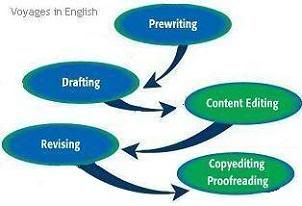
A writer crafts a message.
The writer’s job is to choose words with precision and arrange them carefully to convey meaning. The editor’s job is to ensure that the meaning the writer intends is indeed the one that reader receives. Sounds simple enough. It is. It’s elegant in its simplicity.
A content editor is the first to challenge the writing, looking for problems at the text level in the expression of ideas—logic, clarity, and cohesion. The copyeditor moves down to the sentence level to check for grammar, usage, mechanics, syntax and semantics. Proofreaders follow behind to check spelling and punctuation. They also check to ensure that no new errors have been introduced during the editing process.
This is a critical juncture. The focus has moved from “what” the writer is saying to “how” and “how well” the message is said.
Copyeditors and proofreaders drive some writers crazy. It’s true these specialists worry about things that the rest of us don’t remember. It’s true that on many points even they can’t agree with each other. It’s also true that a misplaced comma in a contract can cost millions of dollars. But more importantly, copyeditors and proofreaders catch errors that cause distractions—errors that get between the reader and the writer’s message.
Copyeditors and proofreaders are the superheroes that protect the writer’s credibility.
The message can be music. The prose can sing. Put a misspelled word in the middle, and the reader will stop for a second or so and lose sight of what the writer was saying.
If you can, get a friend to read after you. I have a friend who does that for me, as my eyes have a slight case of dyslexia. Early each morning she reads my blog and e-mails any corrections to me. She’s heaven sent in more ways than one. I value her. In no way does she make me crazy. I say thank you at least ten times a week.
Post Script
If you must go it alone, here’s a checklist and some tips for you.
Read paper if you can. Your eyes have more experience reading paper. They recognize mistakes in print more quickly than mistakes on screen. If you read on screen, adjust the text size up to a size you’re not used to reading. That will ensure that you see each word individually. In longer documents, check for only one or two checklist items at a time.
Copyediting and Proofreading Checklist
1. Are there any run-on or unnecessary rambling sentences?
2. Are there any unintended sentence fragments?
3. Is there a variety in sentence length and structure?
4. Are any sentences awkward or confusing?
5. Is every sentence logical and grammatically correct?
6. Is the information accurate and correct?
7. Are any words overused, redundant, repeated, or misused?
8. Are transition words used where they are needed?
9. Are all parts of the document included?
10. Are all sentences punctuated correctly?
11. Are all words spelled correctly?
12. Has the document been checked to ensure that no new errors were introduced?
If you let the work (and yourself) rest before you check it, you'll be more successful at finding errors instead of introducing new ones.
—me strauss Letting me be
---------------------------------------------
10 comments:
Liz, if I may be so bold as to throw another tip into the fray.
Read backwards. What I mean is, instead of reading the text the way it was written, start at the back and read the last sentence first and so on till you get to the front. This prevents the writer from mentally filling in continuity where it doesn't exist, since that's what the brain wants to do.
If this makes no sense, let me know and I will try to repost in a more clear way.
Thanks for letting me throw my 2 cents in. :-)
Great list!
Thanks for the list. I'm four chapters from starting the editing phase so need all the tips I can get.
Tree's tip is a good one, but it must be the hardest thing to do - reading backwards. Not good for finding plot holes, I suspect. :)
Thanks Tree, fro adding that.
I've used the read backwards strategy of proofreading myself. It works really well when I want to make sure that every word is right. The logical is based in fact--that we read in phrases not words--and this helps us break that habit to look at the words individually.
Thanks again. Never worry about adding good information around here. I love it when you do.
smiles,
Liz
Hi Karen,
Welcomel
Sounds like you have something good going on. Hope you've noticed that this is part of a series. You might want to check out the earlier pieces since it's too soon for this one.
Good luck with those last four chapters. Then do you want to do mine? :)
smiles,
Liz
This post gave me a new insight, a new idea, in solving my main problems in editing. I am planning to have a friend to do, as you said.
I will make a go for tree's idea too.
Thanks.
Luckily I do a lot of this stuff already, otherwise I'd just never write. (of course, i'm not a pro)
I like Tree's idea, to read backwards. I do that with musis memorizing. It's great for the brain.
Hi Jac,
My friend actually wrote this morning about a missing question mark. Proof it works. :)
Glad to hear that I could be of help. This is one is a series. Hope you find other ideas there as well.
smiles,
Liz
Hi Garnet,
Good to see you. I would bet you do a lot of this stuff already. Your blog is always professionally presented and a great read. As far as doing thing backwards, I think you and I come by that naturally.:)
smiles,
Liz
thanks fot the tips...
Wow Bela,
Thanks for stopping by.
You're welcome.
smiles,
Liz
Post a Comment